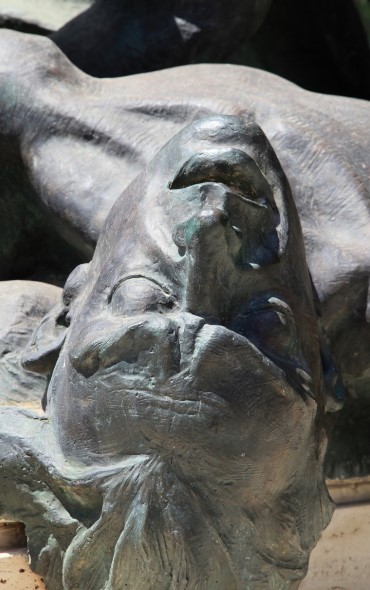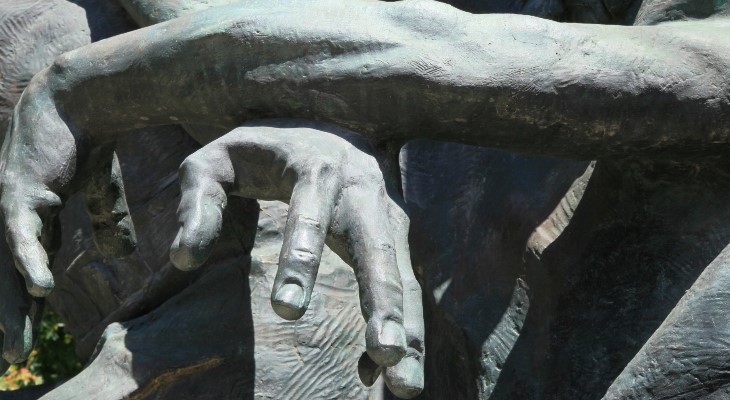As dramatic as the incidents which it commemorates, the monument represents a turning point in Malta’s modern political history.
Dominating St George’s Square in front of the Grandmasters Palace, the monument dedicated to the Sette Giugno riots of 1919 is another work by Anton Agius, one of Malta’s most important 20th century artists and sculptors.
As eminent historian Prof. Henry Frendo describes it, the monument “is in the socialist realist style of the [former Labour Prime Minister] Mintoff era, actually reminiscent of Stalinist times.” Prof. Frendo, who has written extensively about Malta’s modern political history including the 1919 incidents, also remarked how this monument which has come to represent the events of that fateful day “contrasts very markedly with the far more decorous Boris Edwards monument at the Addolorata Cemetery inaugurated in the 1920s.”
In fact, the victims (six in total, as two died later of their wounds, although only four are remembered here) were buried in a joint grave at Malta’s main cemetery on 9th November 1924. The grave was designed by Edwards and Maltese artist Gianni Vella, who witnessed the riots firsthand as he watched a wounded man being carried inside the Circolo La Giovine Malta in St Lucy Street, where the National Assembly was discussing a course of action in its dealings with the British colonial government.
The monument was inaugurated on 7th June 1986, and features six men with naked torsos. Two stand defiantly holding the Maltese flag while the other four, representing the victims and the many who were injured in the riots, are seen dramatically reacting to the events with one succumbing to his wounds. The monument was featured on the reverse side of the LM10 banknote.
It is interesting to note that we always refer to the day in Italian. The national holiday is known as the Sette Giugno day and is never referred to in any other way. In post World War I Malta, Italian was still the language of education and public life, as it had been for centuries until its use was curtailed by decree in 1934 on the eve of Italy’s occupation of Abyssinia, which Britain (then Malta’s colonial rulers) opposed. The events which unfolded on “sette Giugno” of 1919 (and thereafter, as the political unrest continued for several days) “is a distinct historical event of national importance which has come down to us as such inter-generationally,” writes Prof. Frendo. “It has therefore assumed an identity and significance of its own.”
However, the first thing you will notice is that the date and the names of the four victims rendered on the monument’s plinth are in Maltese.
The monument’s artistic qualities have elicited strong views, but none more than its very location. Originally conceived for St George’s Square, it was removed in 2010 and put unceremoniously in storage while the square was being refurbished. It was later placed in Hastings Gardens, where it remained for six years before being brought back to its original location following public consultation. However, not everyone agreed on this move, and the debate surrounding the monument’s location was rather animated.
The Nationalist Party suggested the monument should be placed “close to the country’s highest institution out of respect for the monument’s symbolism and history” but others disagreed, pointing out that it would not fit the ultra-modern design of the new Renzo Piano parliament with its clean lines and severe geometry. Art historian Nikki Petroni was among those who argued in favour of the monument remaining at Hastings Gardens “embellished by trees which, in their serene state provide an adequate counter balance to Agius’ agitated martyrs.” The garden is at the top of Old Bakery Street, where three of the victims died and 50 were injured in the initial uprising, therefore very close to where the action took place and the only open space in that street large enough to accommodate a structure of that size.

Frank Vincentz - commons.wikimedia.org
Petroni describes the monument as being “far from harmonious, but weaved within its distorted and aggressive renditions of the tortured human form is a message, an idea, a moment of unforgettable suffering. It does compel one to stop to look at it, to question its purpose. This is the function of monuments; to make us react, to remember, and to know.”
Anton Agius, who died in 2008, was a prolific artist who was known to have a deep sympathy and compassion for the have-nots and for those less fortunate. Brought up in the workshops of woodcarvers, he would become associated with olive wood carving. He excelled in a number of genres and media, but after initially starting off as an abstract sculptor, Agius changed tack completely and adopted figuration as he felt that “abstraction could not embody the great social changes which Malta was undergoing,” according to art academic Dr Giuseppe Schembri Bonaci, who argues this was “a grave mistake”.
Dr Schembri Bonaci, who has studied Anton Agius in depth and has even written a book about his works, explains that the artist’s change from abstract to figurative art “may well have reflected Malta’s own position at the time. Turbulent times unfolding unheard-of transformations were violently bringing forth a new Malta. The country was beginning to succeed in wedging its interests into world politics, creating more than a few international seismic points, out of proportion to its own size as an island. The Maltese national was asserting its ‘being-ness’ and its presence. Fundamental economic policies and the path towards republicanism upset traditional structures. The attempt to convey social changes through figurative art was magnified by Agius’s energetic though sincere drive to grasp the roots of his nation-in-being, to understand the embryonic nature of Malta and thus to fabricate its spiritual identity in form.”

Frank Vincentz - commons.wikimedia.org
He adds, “Agius wanted to align himself with the working class movement, and demanded that his works should have a clear, comprehensible message: “I want my life to be understood through art … abstract art proved inadequate for this.”
Dr Schembri Dimech continues saying that the artist believed that modernist and abstract art was not capable of reflecting these tremendous changes, that abstract art went against the formation of such spiritual identity, hence his change in direction. He describes Agius's style of socialist realism as "Gothic socialist realism."
It is at this time in his career that Agius created the bulk of his social/political works including the Sette Giugno monument. Dr Schembri Bonaci adds that Agius identified himself with this class position not only theoretically but also materially by including himself in the form of a self-portrait on many of his political monuments including the Sette Giugno one.
Dr Schembri Dimech highlights the rendering of the hands on the figures of the Sette Giugno monument as showing “fantastic work” but concedes “this quality is not consistent throughout the entire monument”.
What do you think?
Sette Giugno is one of five national holidays in Malta. A remembrance service is held at the monument every year on this day.